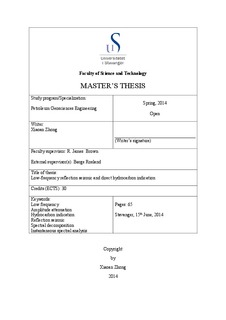| dc.contributor.author | Zhong, Xiaoan | |
| dc.date.accessioned | 2015-08-25T12:12:06Z | |
| dc.date.available | 2015-08-25T12:12:06Z | |
| dc.date.issued | 2014-06 | |
| dc.identifier.uri | http://hdl.handle.net/11250/297931 | |
| dc.description | Master's thesis in Petroleum geosciences engineering | nb_NO |
| dc.description.abstract | Low-frequency reflection seismic has been used as an indicator to detect
hydrocarbons in petroliferous reservoirs. A number of spectral decomposition
methods have been developed to derive seismic from time to frequency domain. The
application of low-frequency seismic computed by the Gabor-Morlet transform
(GMT) and instantaneous spectral analysis (ISA) methods revealed one of lowfrequency
shadow effects, amplitude attenuation, in the southern North Sea.
According to computed low-frequency (< 20 Hz) instantaneous spectral profiles
through discovered wells, strong responses are observed on hydrocarbon-saturated
intervals. By contrast, on higher frequency (> 20 Hz) instantaneous spectral profiles,
frequency amplitude is vanished from the petroliferous intervals, however, strong
responses are presented either above or below these pay zones. The loss mechanism
of high-frequency energy is considered to be contributed by P-wave attenuation of
stratigraphic heterogeneity. This type of low-frequency shadow effect can illustrate
the probable existence of an oil reservoir and can be applied to detect the existence of
hydrocarbon directly. Based on the distribution of attenuated frequency amplitude, a
total of 140 km2 of prospects have been identified from both Cretaceous-Paleogene
chalk reservoirs and sandstones beneath the basal Cretaceous unconformity (BCU). The identified chalk prospects are mainly distributed along the rim of anticlines on the
Lindesnes Ridge, while prospective clastics are stratigraphically entrapped on the
slope of the Grensen Nose. In addition to using low-frequency reflection seismic to
detect hydrocarbon directly, frequency components can be applied to calibrate the
interpretations of horizons and faults as well. | nb_NO |
| dc.language.iso | eng | nb_NO |
| dc.publisher | University of Stavanger, Norway | nb_NO |
| dc.relation.ispartofseries | Masteroppgave/UIS-TN-IPT/2014; | |
| dc.subject | petroleumsgeologi | nb_NO |
| dc.subject | petroleum engineering | nb_NO |
| dc.subject | amplitude attenuation | nb_NO |
| dc.subject | hydrocarbon indication | nb_NO |
| dc.subject | reflection seismic | nb_NO |
| dc.subject | spectral decomposition | nb_NO |
| dc.subject | instantaneous spectral analysis | nb_NO |
| dc.title | Low-frequency reflection seismic and direct hydrocarbon indication | nb_NO |
| dc.type | Master thesis | nb_NO |
| dc.subject.nsi | VDP::Technology: 500::Rock and petroleum disciplines: 510::Geological engineering: 513 | nb_NO |
